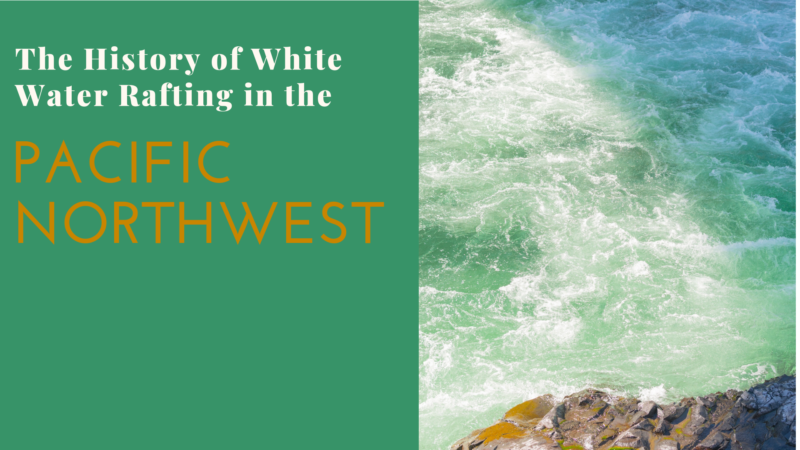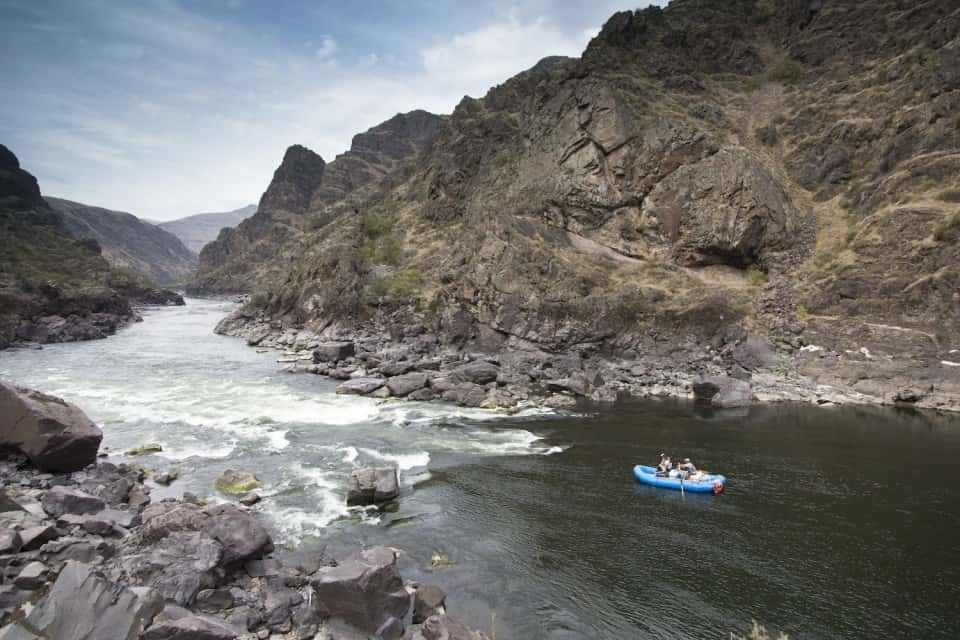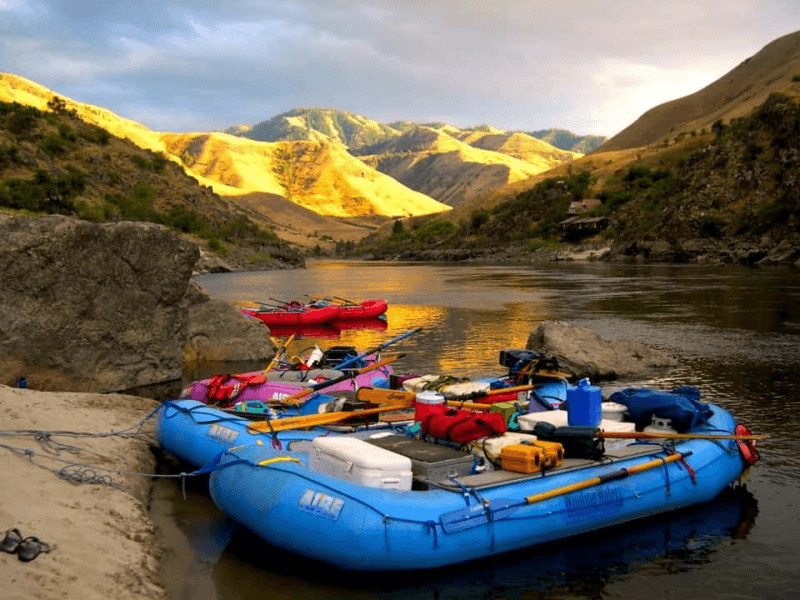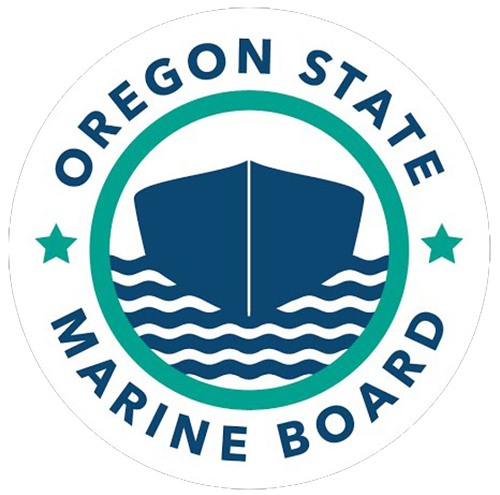The History of Whitewater Rafting in Oregon
Rivers are as much a part of the Pacific Northwest as the rainy weather, dense forests, and legendary Salmon population. Interesting how these are all connected!
With all of these factors playing such a part in the history and culture of our beautiful state and region, it’s no wonder that white water rafting has turned into something of a state sport.
In this post, we’ll explore why is it called
white water rafting, how it evolved from simply a way to travel rivers to a sport that adventurers from around the world travel thousands of miles to experience.
The Columbia River drainage
Before we take a look at the history of rafting itself, let’s take time consider why we’re able to raft here in the Joseph area: The Columbia River drainage.
The mighty Columbia River rafting experience draws water from areas stretching deep into British Columbia and Alberta, to as far south as Utah and Nevada. It’s such a big area and large amount of water that the Columbia River has the second largest drainage in the United States after the Mississippi River!
Unlike the Mississippi River however, much of the river and its major tributaries, which include the
Snake ,
Salmon ,
Grande Ronde , and mainstem Columbia Rivers, lie in mountainous regions. These rivers are changing elevation rapidly, which leads to our area’s famed white, rushing water—ideal for white water rafting Columbia River trips.
A means for travel
While we love the area’s mountains for their beauty, recreational opportunities, and white water rafting, they posed a massive logistical hurdle for travel prior to the advent of highways. Travel in those days was limited, and traversing snowy, treacherous mountains was dangerous and time consuming.
For this reason, the rivers and valleys they created offered the easiest way for extended travel in the area. Unlike mountain passes, rivers avoided dense forests, strenuous elevation gain, and allowed you to haul cargo long distances with little effort.
This doesn’t mean river travel did not have its drawbacks: you still had to find a way back up river, white water posed a challenge for unskilled rivermen, and it was dangerous in the days before high buoyancy whitewater rafting raft and lifejackets.
Still, for native people and early settlers of the region, white water boating and the regions river “highway” system made their lives a lot easier.
Native people and white water rafting
The original people of the Northwest were members of the many tribes of the region. As such, the tribes surrounding the Snake River were the first to leverage the power of the mighty rivers and are credited as the true inventors of white water rafting. These tribes included:
- Nez Perce
- Yakama
- Warm Springs
- Colville
- Cowlitz
- Spokane
- Cayuse
- Palus
- Umatilla
- Coeur d’Alene
While these tribes did use rafting for transportation, they primarily traversed white water for fishing. Salmon fishing was (and is) a deeply entrenched part of native culture in the Pacific Northwest, and these tribes developed advanced methods for Salmon fishing.
Salmon populations ebb and flow with the seasons; generally coming up the Columbia from the Pacific Ocean in two separate runs in the spring and fall. Since these Salmon runs were the primary food source for these tribes, catching enough during these windows was crucial for the survival of their people. Owyhee River whitewater rafting and Umpqua River rafting styles evolved from these cultural practices. Whitewater Raftings in these areas today trace their legacy back to these tribes.
White water rafting provided an opportunity to more effectively fish these waters, increasing their efficiency and providing them with enough food to last the periods where there were no fish in the water. White water rafting was born out of this cultural necessity.
Lewis and Clark
As Lewis and Clark barreled west, a key ally in their journey were the native people of the American West. Nowhere was this more true than in the Pacific Northwest.
Lewis and Clark did not know what to expect as they traveled farther and farther away from civilization. Moving through forests and rivers was difficult, and though native guides assisted in their journey, they did not have the cultural knowhow of how to move through such rugged terrain.
Enter the Nez Perce tribe, who gave the overwhelmed explorers rafts and guides to move down the Columbia River towards Astoria. Like that, the Nez Perce both introduced white water rafting in Texas to Western culture and helped Lewis and Clark reach the Pacific Ocean.
Popularization and rubber rafts
After Lewis and Clark traversed the Columbia, rafting as a way to move through the region became more popular. Still, with the technology of the era (or lack-thereof) and the relative unknowns of the rivers, trips throughout the area were still extremely dangerous and difficult. While it was still safer and easier than other means, survival was not guaranteed.
Native people and Lewis and Clark were not using the highly durable and easy-to-navigate white water rafts of today. The most technologically available raft of the day was a craft called a keelboat. This boat combined many advantages of boats from the river and included a streamlined hull shape, a steering device called a keel, and the ability to carry a large number of people and gear.
Eventually, an expedition of the Platte River in Nebraska by Lieutenant John Fremont led to the creation of a rubber raft reinforced with a wooden frame. John W. Powell’s expedition of the Colorado River through the Grand Canyon in 1869 employed the same style boat. This turned him into a legend and the modern white water raft as the best way to traverse high gradient white water rivers.
The rise of white water rafting as a sport
The spirit of adventure reverberates throughout the sport of whitewater rafting Olympics to this day. Once common methods were developed for rafting through white water, adventure seekers beyond those simply attempting to travel were interested in white water rafting.
The first ever commercial white water rafting Columbia River trip took place here on the Salmon River in Idaho in 1940. Particularly in the Pacific Northwest, the sport took off and non-professionals were able to take advantage of exploration opportunities in the many rivers the region has. Today,
gear and extensive training allow for whitewater rafting to be a fun and exciting adventure for all ages.
White water raft in the legendary waters of the Snake and Grande Ronde Rivers
Given the history of the region and its importance in the development of our beloved sport, the holy waters of the Columbia River drainage have turned into a mecca of whitewater rafting.
The rivers are still largely preserved to what they were during Lewis and Clark’s days. This means you can experience the adventure of years past on the wild rivers that defined the American West.
Winding Waters River Expeditions offers a number of trips for all ages, experience levels, and trip lengths. We think everyone should be able to enjoy these pristine rivers that are so crucial to the development of our beautiful state, region, and country.
Thrilling, refreshing, unforgettable—see why guests rave about Winding Waters rafting trips by checking out our
Google Business Profile Reviews today!










